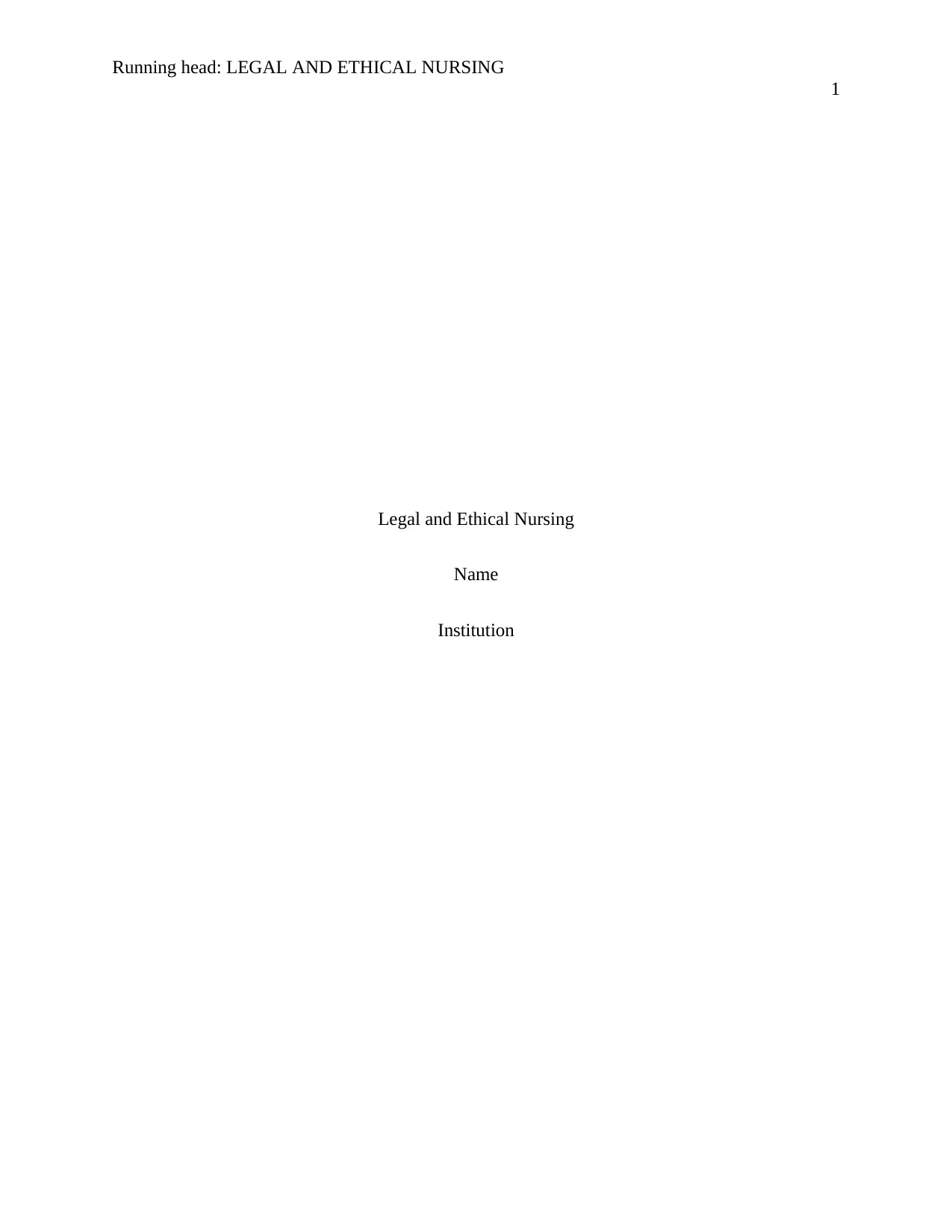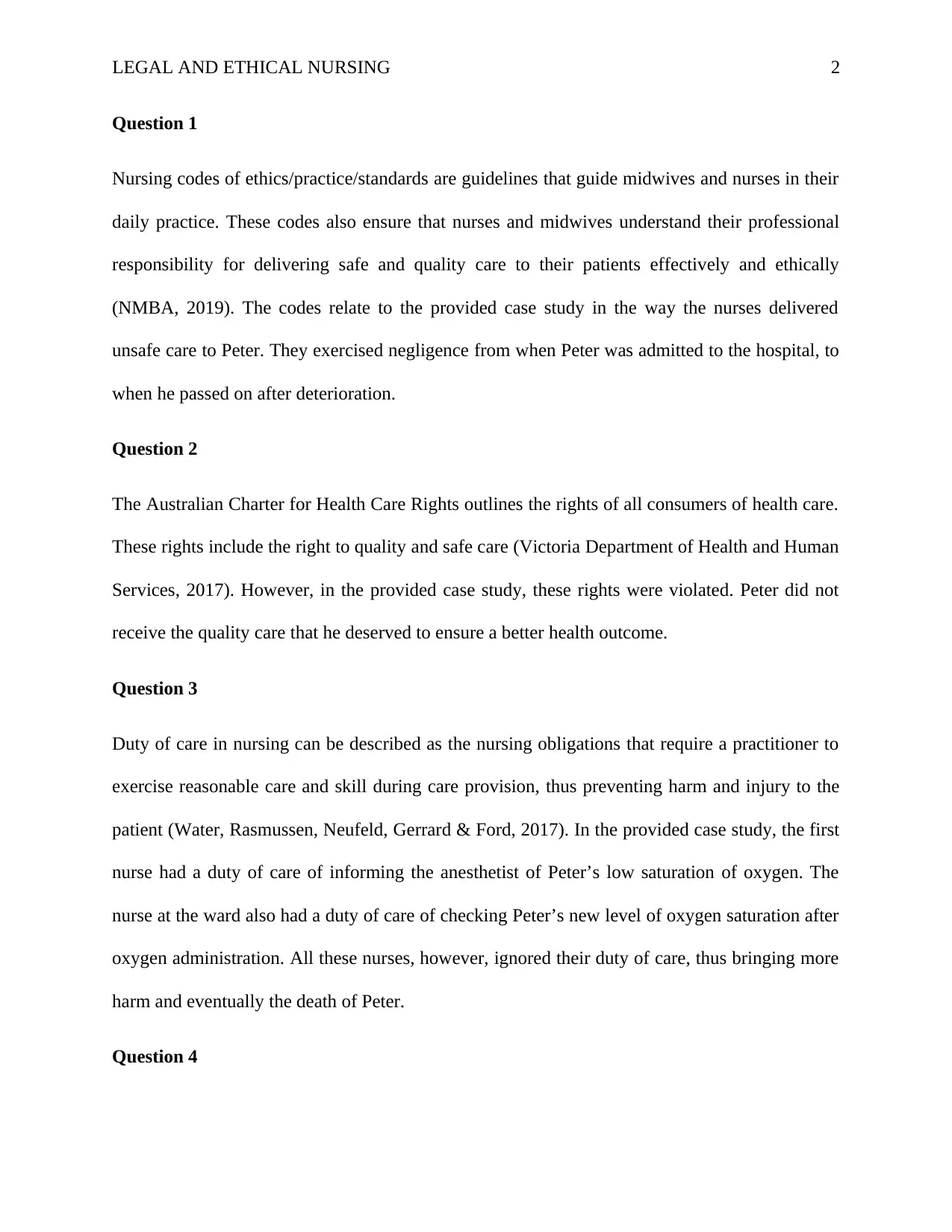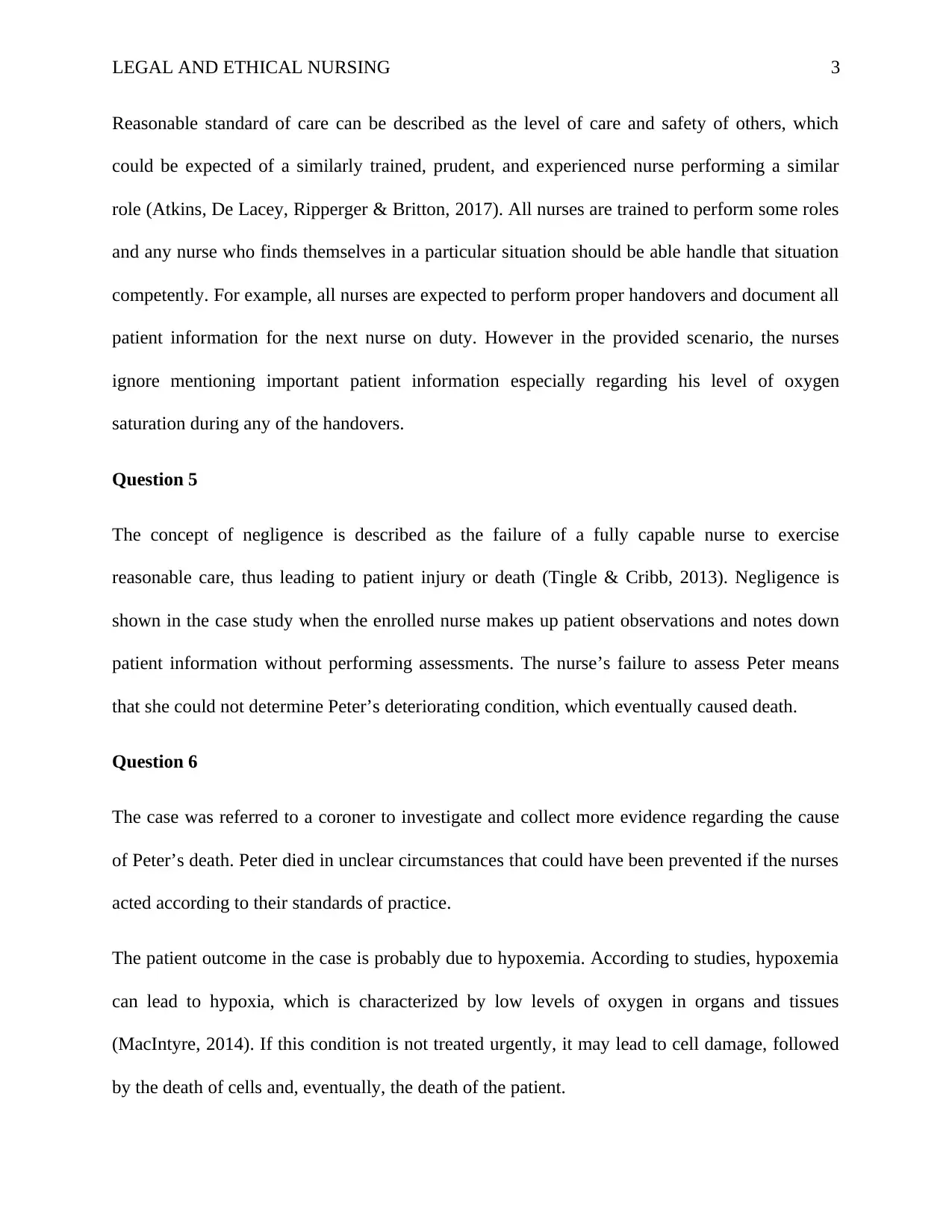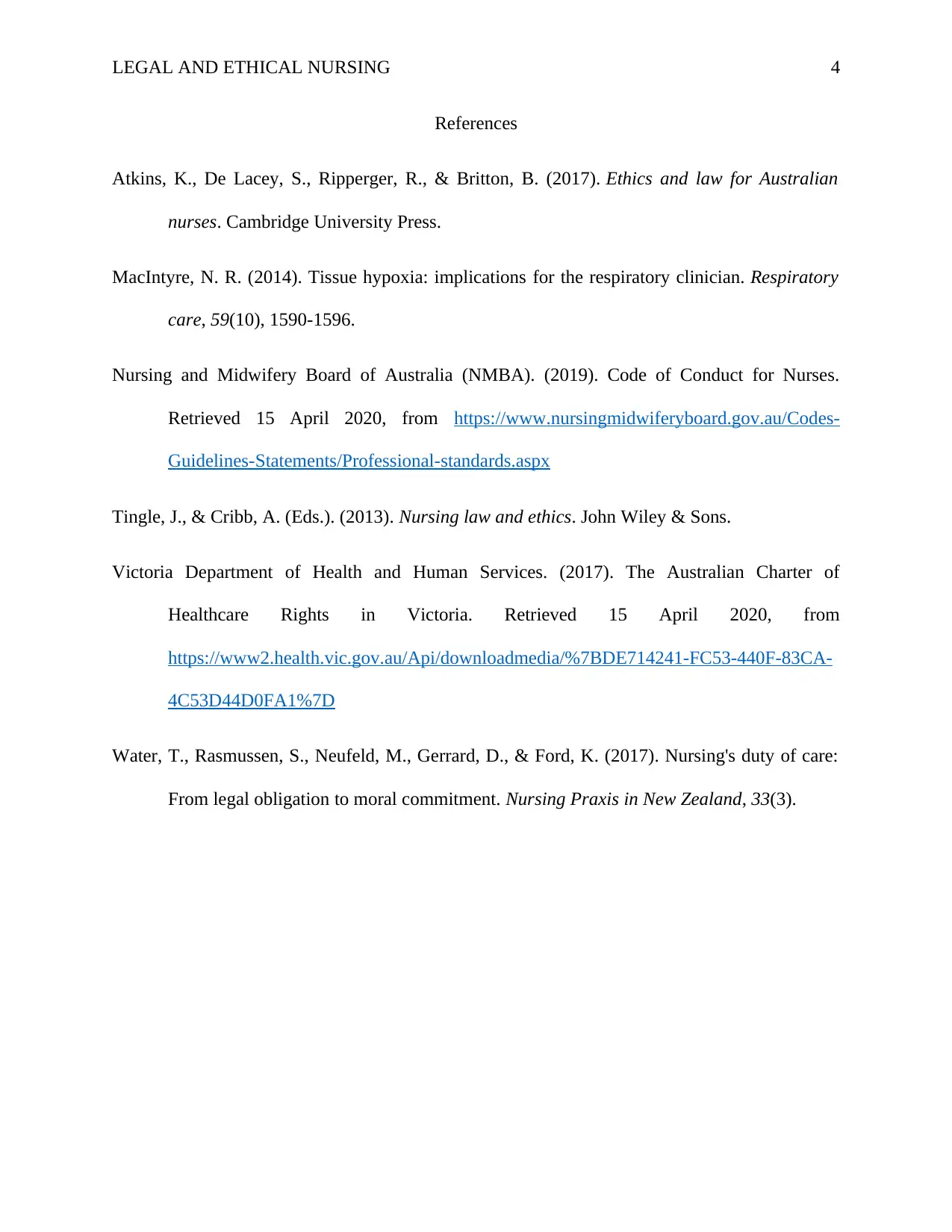Legal and Ethical Nursing: Case Study Analysis and Discussion
VerifiedAdded on 2022/09/26
|5
|827
|18
Case Study
AI Summary
This assignment presents a case study involving Peter Sutcliffe, who underwent elective surgery and subsequently experienced a decline in health due to inadequate nursing care. The analysis addresses several key areas: the application of nursing codes of ethics and practice, the violation of the Australian Charter for Health Care Rights, the nurses' failure to uphold their duty of care, and the concept of a reasonable standard of care. The case highlights instances of negligence, such as the enrolled nurse fabricating patient observations, and concludes with a discussion of the coroner's investigation into Peter's death, likely caused by hypoxemia. The assignment references relevant literature to support the analysis of these critical issues within the healthcare setting.

Running head: LEGAL AND ETHICAL NURSING
1
Legal and Ethical Nursing
Name
Institution
1
Legal and Ethical Nursing
Name
Institution
Paraphrase This Document
Need a fresh take? Get an instant paraphrase of this document with our AI Paraphraser

LEGAL AND ETHICAL NURSING 2
Question 1
Nursing codes of ethics/practice/standards are guidelines that guide midwives and nurses in their
daily practice. These codes also ensure that nurses and midwives understand their professional
responsibility for delivering safe and quality care to their patients effectively and ethically
(NMBA, 2019). The codes relate to the provided case study in the way the nurses delivered
unsafe care to Peter. They exercised negligence from when Peter was admitted to the hospital, to
when he passed on after deterioration.
Question 2
The Australian Charter for Health Care Rights outlines the rights of all consumers of health care.
These rights include the right to quality and safe care (Victoria Department of Health and Human
Services, 2017). However, in the provided case study, these rights were violated. Peter did not
receive the quality care that he deserved to ensure a better health outcome.
Question 3
Duty of care in nursing can be described as the nursing obligations that require a practitioner to
exercise reasonable care and skill during care provision, thus preventing harm and injury to the
patient (Water, Rasmussen, Neufeld, Gerrard & Ford, 2017). In the provided case study, the first
nurse had a duty of care of informing the anesthetist of Peter’s low saturation of oxygen. The
nurse at the ward also had a duty of care of checking Peter’s new level of oxygen saturation after
oxygen administration. All these nurses, however, ignored their duty of care, thus bringing more
harm and eventually the death of Peter.
Question 4
Question 1
Nursing codes of ethics/practice/standards are guidelines that guide midwives and nurses in their
daily practice. These codes also ensure that nurses and midwives understand their professional
responsibility for delivering safe and quality care to their patients effectively and ethically
(NMBA, 2019). The codes relate to the provided case study in the way the nurses delivered
unsafe care to Peter. They exercised negligence from when Peter was admitted to the hospital, to
when he passed on after deterioration.
Question 2
The Australian Charter for Health Care Rights outlines the rights of all consumers of health care.
These rights include the right to quality and safe care (Victoria Department of Health and Human
Services, 2017). However, in the provided case study, these rights were violated. Peter did not
receive the quality care that he deserved to ensure a better health outcome.
Question 3
Duty of care in nursing can be described as the nursing obligations that require a practitioner to
exercise reasonable care and skill during care provision, thus preventing harm and injury to the
patient (Water, Rasmussen, Neufeld, Gerrard & Ford, 2017). In the provided case study, the first
nurse had a duty of care of informing the anesthetist of Peter’s low saturation of oxygen. The
nurse at the ward also had a duty of care of checking Peter’s new level of oxygen saturation after
oxygen administration. All these nurses, however, ignored their duty of care, thus bringing more
harm and eventually the death of Peter.
Question 4

LEGAL AND ETHICAL NURSING 3
Reasonable standard of care can be described as the level of care and safety of others, which
could be expected of a similarly trained, prudent, and experienced nurse performing a similar
role (Atkins, De Lacey, Ripperger & Britton, 2017). All nurses are trained to perform some roles
and any nurse who finds themselves in a particular situation should be able handle that situation
competently. For example, all nurses are expected to perform proper handovers and document all
patient information for the next nurse on duty. However in the provided scenario, the nurses
ignore mentioning important patient information especially regarding his level of oxygen
saturation during any of the handovers.
Question 5
The concept of negligence is described as the failure of a fully capable nurse to exercise
reasonable care, thus leading to patient injury or death (Tingle & Cribb, 2013). Negligence is
shown in the case study when the enrolled nurse makes up patient observations and notes down
patient information without performing assessments. The nurse’s failure to assess Peter means
that she could not determine Peter’s deteriorating condition, which eventually caused death.
Question 6
The case was referred to a coroner to investigate and collect more evidence regarding the cause
of Peter’s death. Peter died in unclear circumstances that could have been prevented if the nurses
acted according to their standards of practice.
The patient outcome in the case is probably due to hypoxemia. According to studies, hypoxemia
can lead to hypoxia, which is characterized by low levels of oxygen in organs and tissues
(MacIntyre, 2014). If this condition is not treated urgently, it may lead to cell damage, followed
by the death of cells and, eventually, the death of the patient.
Reasonable standard of care can be described as the level of care and safety of others, which
could be expected of a similarly trained, prudent, and experienced nurse performing a similar
role (Atkins, De Lacey, Ripperger & Britton, 2017). All nurses are trained to perform some roles
and any nurse who finds themselves in a particular situation should be able handle that situation
competently. For example, all nurses are expected to perform proper handovers and document all
patient information for the next nurse on duty. However in the provided scenario, the nurses
ignore mentioning important patient information especially regarding his level of oxygen
saturation during any of the handovers.
Question 5
The concept of negligence is described as the failure of a fully capable nurse to exercise
reasonable care, thus leading to patient injury or death (Tingle & Cribb, 2013). Negligence is
shown in the case study when the enrolled nurse makes up patient observations and notes down
patient information without performing assessments. The nurse’s failure to assess Peter means
that she could not determine Peter’s deteriorating condition, which eventually caused death.
Question 6
The case was referred to a coroner to investigate and collect more evidence regarding the cause
of Peter’s death. Peter died in unclear circumstances that could have been prevented if the nurses
acted according to their standards of practice.
The patient outcome in the case is probably due to hypoxemia. According to studies, hypoxemia
can lead to hypoxia, which is characterized by low levels of oxygen in organs and tissues
(MacIntyre, 2014). If this condition is not treated urgently, it may lead to cell damage, followed
by the death of cells and, eventually, the death of the patient.
⊘ This is a preview!⊘
Do you want full access?
Subscribe today to unlock all pages.

Trusted by 1+ million students worldwide

LEGAL AND ETHICAL NURSING 4
References
Atkins, K., De Lacey, S., Ripperger, R., & Britton, B. (2017). Ethics and law for Australian
nurses. Cambridge University Press.
MacIntyre, N. R. (2014). Tissue hypoxia: implications for the respiratory clinician. Respiratory
care, 59(10), 1590-1596.
Nursing and Midwifery Board of Australia (NMBA). (2019). Code of Conduct for Nurses.
Retrieved 15 April 2020, from https://www.nursingmidwiferyboard.gov.au/Codes-
Guidelines-Statements/Professional-standards.aspx
Tingle, J., & Cribb, A. (Eds.). (2013). Nursing law and ethics. John Wiley & Sons.
Victoria Department of Health and Human Services. (2017). The Australian Charter of
Healthcare Rights in Victoria. Retrieved 15 April 2020, from
https://www2.health.vic.gov.au/Api/downloadmedia/%7BDE714241-FC53-440F-83CA-
4C53D44D0FA1%7D
Water, T., Rasmussen, S., Neufeld, M., Gerrard, D., & Ford, K. (2017). Nursing's duty of care:
From legal obligation to moral commitment. Nursing Praxis in New Zealand, 33(3).
References
Atkins, K., De Lacey, S., Ripperger, R., & Britton, B. (2017). Ethics and law for Australian
nurses. Cambridge University Press.
MacIntyre, N. R. (2014). Tissue hypoxia: implications for the respiratory clinician. Respiratory
care, 59(10), 1590-1596.
Nursing and Midwifery Board of Australia (NMBA). (2019). Code of Conduct for Nurses.
Retrieved 15 April 2020, from https://www.nursingmidwiferyboard.gov.au/Codes-
Guidelines-Statements/Professional-standards.aspx
Tingle, J., & Cribb, A. (Eds.). (2013). Nursing law and ethics. John Wiley & Sons.
Victoria Department of Health and Human Services. (2017). The Australian Charter of
Healthcare Rights in Victoria. Retrieved 15 April 2020, from
https://www2.health.vic.gov.au/Api/downloadmedia/%7BDE714241-FC53-440F-83CA-
4C53D44D0FA1%7D
Water, T., Rasmussen, S., Neufeld, M., Gerrard, D., & Ford, K. (2017). Nursing's duty of care:
From legal obligation to moral commitment. Nursing Praxis in New Zealand, 33(3).
Paraphrase This Document
Need a fresh take? Get an instant paraphrase of this document with our AI Paraphraser

LEGAL AND ETHICAL NURSING 5
1 out of 5
Related Documents
Your All-in-One AI-Powered Toolkit for Academic Success.
+13062052269
info@desklib.com
Available 24*7 on WhatsApp / Email
![[object Object]](/_next/static/media/star-bottom.7253800d.svg)
Unlock your academic potential
Copyright © 2020–2025 A2Z Services. All Rights Reserved. Developed and managed by ZUCOL.





